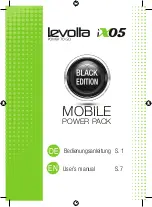
ViaLite
quick start guide
www.vialite.com
Hxx-QS-HB-3 VialiteHD Quick Start Guide
Page 1
CR3134
PPM
ViaLiteHD
Quick Start Guide
This quick start guide is intended as an information summary, the relevant equipment
handbook should always be treated as the master document.
Initial Inspection
Unpack and inspect the equipment as soon as possible. If there is any sign of damage or any parts missing, do not install the equipment before seeking advice from PPM
or your local agent. The equipment received should match the delivery note that is shipped with the equipment. If there are any discrepancies, contact PPM or your
local agent.
Electrical Safety
ViaLiteHD
HPS Power Supply Units are Safety Class 1 products (having metal case directly connected to earth via the power supply cable). The unit is
also fitted with an earthing/grounding stud connected to the power supply earth. When operating the equipment note the following precautions:
Hazardous voltages exist within the equipment. There are no user serviceable parts inside; the covers should only be removed by qualified technician.
The equipment does not have a mains isolating switch. Equipment must be installed within easy reach of a dual pole mains isolation switch.
There are no user replaceable fuses in the rack mounted equipment. Replacement should only be carried out by a PPM technician.
ESD Precautions
Precautions for handling electro-static sensitive devices should be observed when handling all
ViaLiteHD
modules. Technicians should ensure that they
use effective personal grounding (i.e. ESD wrist strap etc..) when servicing the equipment. Any equipment or tools used should be grounded to prevent
static charge buildup. Good practice should be observed at all times for reference see relevant standards.
EN 61340-5-
1, “Protection of Electronic Devices from Electrostatic Phenomena – General Requirements”
Optical Safety
The
ViaLiteHD
RF Transmitter modules contain laser diode sources operating at nominal wavelengths of 1270nm to 1610nm.
These devices are rated as EN60825-1:1994 CLASS 1 radiation emitting devices. A class 1 laser is safe under all conditions of normal use.
When operating the equipment note the following precautions:
Never look into the end of an optical fibre directly or by reflection either with the naked eye or through an optical instrument.
Never leave equipment with radiating bare fibres
– always cap the connectors.
Do not remove equipment external covers when operating.
ViaLiteHD
and
ViaLite
Classic compatibility
The RF and optical interfaces of
ViaLiteHD
and
ViaLite
Classic
are compatible. Hence it is possible for units of different types to interwork and be used to expand
existing systems. However the physical size, mounting systems and control of the units are different, so it will not be possible to mix systems in a single rack or housing.
Contact PPM for more details.
Cleaning optical connectors
Optical connectors MUST be cleaned before use.
Most performance issues are due to dirty fibres
.
For more details please read the cleaning instruction which accompanies the connector cleaning kit. Details can also be found on the CD supplied with your equipment.
Blindmate Optical and RF Connectors
Note that the
ViaLiteHD
Blindmate system will simultaneously mate electrical, RF and optical backplane connectors, so both RF and optical connectors need to be
prepared. Firstly inspect the rear Blindmating plate, ensure that the connector barrels are fitted into all RF connectors and are centrally aligned. Remove any protective
covers from the optical connectors. Fit the Blindmating plate into the appropriate slot at the rear of the rack. For module installation see the following section.
Connect the external system cables to optical and RF interfaces. External interface SMA RF connectors should only be connected with a calibrated SMA torque
spanner. External optical interface SC/APC adaptors are fitted with a sprung protective cover. To connect SC/APC optical connectors, remove the plug protective cover.
Open the adaptor sprung cover, align the connector keyway slot in the adaptor to the key of the plug. Gently push the plug into the adapter until a click is heard and the
connector locks. To disconnect, grip the body of the plug and gently pull the plug from the adaptor, replace the protective cover.
-
Peel the plastic cover from an unused “N” cleaning pad.
- Hold the connector between your thumb and forefinger
Clean the connector using firm pressure by swiping in a
pendulum motion through each segment of the “N” shape,
following the diagram
- Do not swipe over the same space twice.






















